Osteoporosis is a condition in which bones become fragile and brittle, leading to a higher risk of fractures than normal bones.
Osteoporosis occurs when bones lose minerals, such as calcium, more quickly than the body can replace them. This leads to a loss of bone mass or density. When bones are thinner and less dense, even a minor bump or accident may cause fractures.
Any bone can be affected by osteoporosis. The most common sites are bones in the hip, spine, wrist, ribs, pelvis and upper arm. Osteoporosis usually has no signs or symptoms until a fracture occurs. This is why osteoporosis is often called the ‘silent disease’.
Fractures due to osteoporosis can lead to changes in posture, muscle weakness, height loss and bone deformity of the spine. Fractures may lead to chronic pain, disability, loss of independence and even premature death.
Causes:
- Oestrogen deficiency – bone loss accelerates after menopause. Young women who cease menstruating (e.g. thin athletes or anorexia) have compromised bone density.
- Surgical removal of ovaries – the ovaries are a major oestrogen producer.
- Hyperparathyroidism causes calcium loss urine at the expense of bone.
- Growth hormone plays a role in building strong bones.
- Nutrient deficiencies – calcium, vitamin D, vitamin K, phosphorus, magnesium and boron.
- Smoking – associated with brittle bones as toxic effects from nicotine block the ability of bone cells to absorb vital nutrients.
- Medications – corticosteroids (cortisone, hydrocortisone, glucocorticoids and prednisone). Used to treat asthma, rheumatoid arthritis, psoriasis and Inflammatory Bowel Disease.
- Acidic diet – alcohol, caffeine, meat, dairy products, processed grains, sugar and carbonated beverages. Blood pH must be tightly regulated between 7.35 and 7.45 (1 is acidic and 14 is alkaline). Western diet and stress are acidic. Calcium and magnesium are alkaline minerals. When our blood becomes too acidic, the body liberates these minerals out of our bones to neutralise the acidic environment. Overtime this reduces bone density.
- Fluoride negatively affects bone by precipitating calcium out of solution resulting in hypocalcaemia (low blood calcium). It also weaken collagen, which usually strengthens bone. Dental fluorosis indicates fluoride exposure during enamel development.
- Inactivity – lack of weight bearing exercise.
- High sodium diet – salt, takeaways and processed foods. Sodium chloride (table salt) elevates urinary excretion, promoting bone loss.

Risk Factors:
- Gender – females are at greater risk than males.
- Age – increases risk.
- Ethnicity – Caucasian and Asian are at greater risk.
- Family history – direct family member (parent or sibling) with Osteoporosis, especially if they have had a hip fracture.
- Body frame size – less bone mass to draw upon.
Natural Remedies:
- Calcium – dairy products, leafy green vegetables, tahini, figs, molasses, almonds, fish with edible bones, soy beans (tofu) and oranges. Calcium is the most abundant mineral in the body. About 99% of our calcium is stored in bones and teeth.
- Vitamin D – fatty fish, eggs, mushrooms, tofu, dairy products and meat, however, mostly from the sun. Vitamin D enhances calcium absorption into bone.
- Vitamin K – leafy green vegetables, prunes, cucumber, soy beans (tofu), olive oil and fermented foods. Vitamin K effectively holds minerals in bone matrix.
- Phosphorus – meat, seafood, dairy, nuts, seeds and legumes. Phosphorus is the second most abundant mineral in the body. About 85% of our phosphorus is stored in bones and teeth.
- Magnesium – leafy green vegetables, nuts and seeds. About 60% of our magnesium is stored in bones and teeth. Magnesium is required for the absorption and metabolism of calcium. It also stimulates the thyroid’s production of calcitonin, a bone preserving hormone. Additionally, it is required for the conversion of vitamin D to its active form. Tip: a simple test to determine if you are magnesium deficient i to stick your tongue out in front of a mirror – slight shaking or quivering indicates magnesium deficiency.
- Boron – most plant foods. Boron is mostly found in bones and teeth. It promotes absorption of calcium, phosphorus and magnesium, while reducing calcium excretion.
- Reduce oxalates – dark chocolate, coffee, rhubarb, beetroot, almonds and too many raw leafy green vegetables. Oxalates bind with calcium and promote calcium loss.
- Avoid carbonated beverages – soda and fizzy drinks. These are acidic in our blood.
- Phytoestrogen foods – soybeans (tofu), flaxseeds, alfalfa, yams, and many whole grains and legumes. Phytoestrogens mimic oestrogen in our body as they are plant replicas.
- Growth hormone regulates bone metabolism and formation. Growth hormone, directly and through insulin-like growth factor, stimulates osteoblast proliferation and activity, promoting bone formation. While stimulating osteoclast differentiation and activity, promoting bone resorption. This results in an increase in the overall rate of bone remodelling, with the net effect of bone accumulation. Growth hormone promotes lean body mass. Ways to increase growth hormone – lose fat (if necessary) and build muscle, strength training, intermittent fasting, reduce stress, support the adrenals, obey your circadian rhythm (high intensity exercise earlier in the day to support cortisol pattern), quality sleep, balance blood sugar and reduce insulin spikes. Animal foods like meat and dairy products are naturally high in insulin-like growth factor.
- Weight bearing exercise including weight training, body weight exercises, walking/jogging, stair climbing and sports. This type of exercise forces your body to work against gravity. This strengthens bone and muscles simultaneously.
- Sulphur containing foods – eggs, garlic, onions and cruciferous vegetables (broccoli, cauliflower, cabbage, bok choy, kale, radish, turnips and watercress). Sulphur is the third most abundant mineral in the body. It is necessary for collagen synthesis.
- Alkaline diet – abundance of fruit and vegetables.
- Filtered water reduces fluoride exposure.
- Reduce sodium – prepare foods from scratch and add less salt.

Consult with me to individualise your recommendations.




